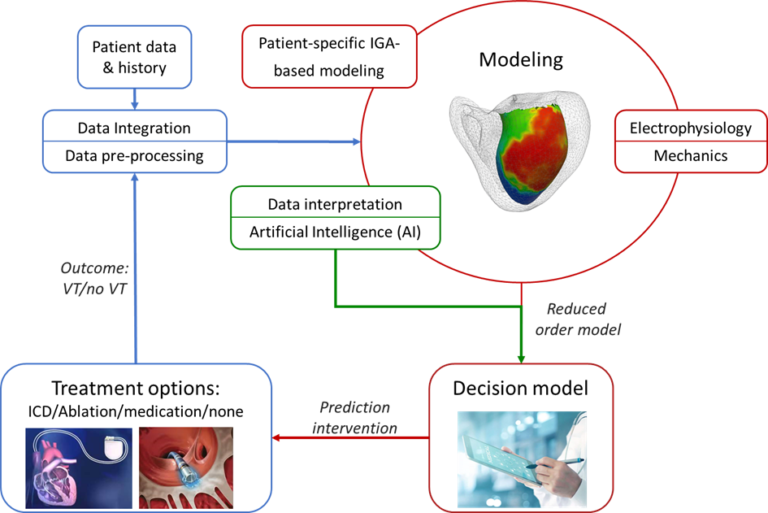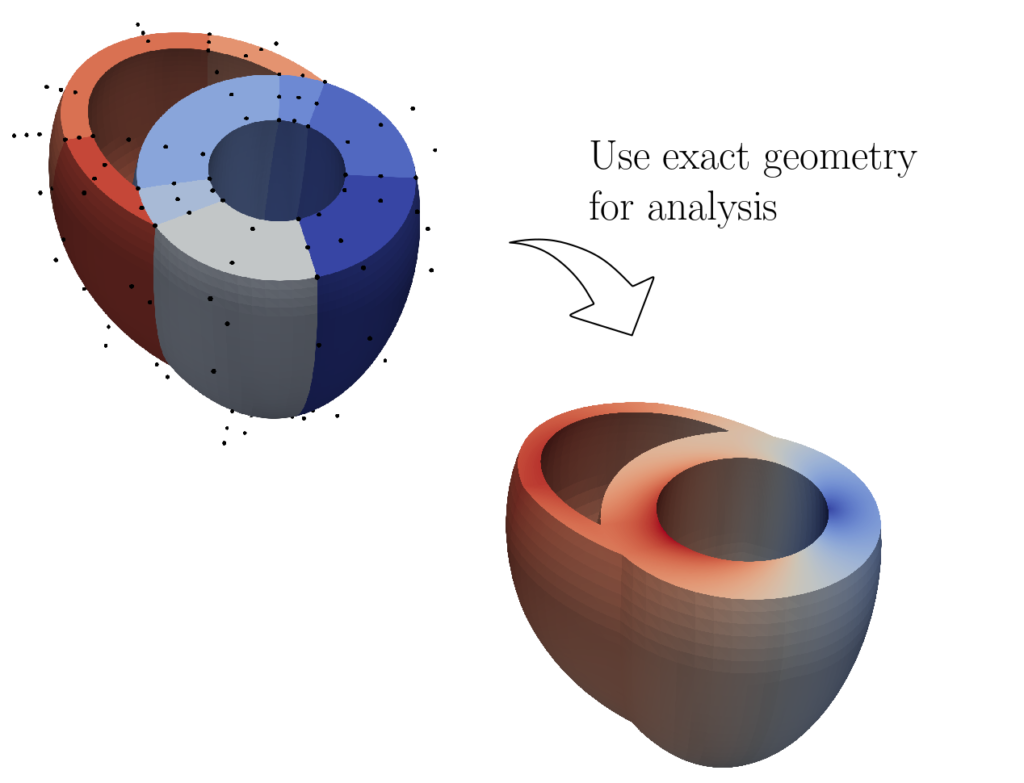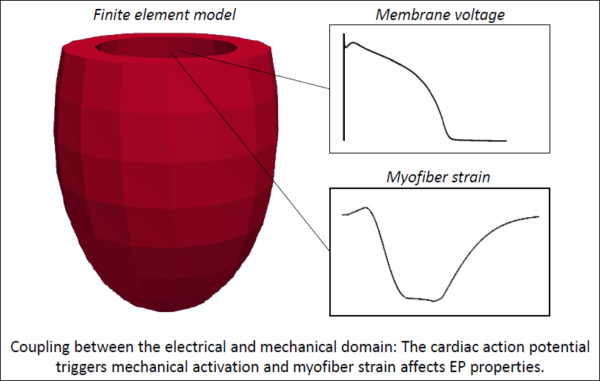About the project
Our vision of the future
Predictive personalized Modeling
Post-myocardial infarct patients have an increased risk for scar-based ventricular tachycardia (VT), an abnormal heart rhythm, which may lead to sudden cardiac death (SCD). Ablation therapy is used to treat VTs, but has moderate success rates of 50- 80%. Secondly, an implanted cardioverter defibrillator (ICD) can help prevent SCD if ablation is inexecutable. Current guidelines for ICD treatment are based on left ventricular ejection fraction but prove to be insufficient in identifying patients with a high risk of VT. The electro-mechanical interaction of the heart is key to understand VT development. Here, patient-specific computational models can be used to create a cardiac Digital Twin which can serve as a decision support tool in the clinic.
Our project uses Data Integration on patient data & history, for Patient-specific IGA modeling, Electro-mechanically coupled modeling and Artificial Intelligence modeling. The resulting decision model can be used to improve the understanding and prediction of the occurrence of Ventricular Tachycardias and provide optimized patient-specific treatment using computationally efficient models.

Data integration & Pre-processing
Melissa Niemantsverdriet
Marloes de Winter

The linking pin between the technological research performed by the PhD students and the clinical application: A clinical workflow is developed in order to acquire patient-specific data. In this workflow, the data is semi-automatically obtained, analyzed and processed to be used for the physiological and data models of the COMBAT-VT project. This workflow has five essential components:
- Selection of patients;
- Obtaining the data from the different information systems at the hospital;
- Saving data according to the FAIR principles;
- Analyzing the data to explore what is exactly saved from the patients and what is useful for the models;
- Preprocessing the data and sharing the data with the PhD researchers working at the TU/e and providing insight with a clinical data interface.
Patient-specific IGA-based modeling
Current electromechanical ventricular models using Finite Element Analysis (FEA) are computationally expensive, which is impractical for clinical applications. Furthermore, patient-specific FEA models rely on accurate input data to produce meaningful results. We propose an approach in which the Isogeometric Analysis (IGA) paradigm is applied to existing mechanical ventricular models subject to limited available input data. IGA enables the construction of smooth discretized geometries, which require fewer degrees of freedom, making them ideal for clinical applications.
In this project, we present a method for constructing a template bi-ventricle NURBS geometry comprised of two truncated ellipsoids, with a rule-based fiber distribution. We target the mapping of the template geometry onto patient-specific ultrasound scan-data. Mechanical simulations are performed within the IGA framework and will be coupled to electrophysiological simulations.
IGA is expected to reduce the computational effort when compared to the currently used methods in the literature while enabling an accurate representation of the development and behavior of VTs.
Robin Willems


Electro-mechanical modeling
Electrophysiological VT simulations rely on geometrical information of the infarct area, where the remodeling of tissue properties is limited to this area in the current electrophysiological modeling pipeline. However, in mechanical simulations, functional abnormalities are detected outside this infarct area as well, where deformations of the nearby remote area are affected by the dysfunctional infarct. In this project, such mechanical abnormalities are linked to electrophysiological remodeling. Here, abnormal strain distributions over the heart are assumed to affect the redistribution of remodeled electrophysiological properties over time. The effects of this hypothesis on long term computational VT risk predictions are further explored to investigate if it might explain the progression of VT risk over time as observed in the clinic.
Evianne Kruithof
Artificial intelligence modeling
Currently, physicians mainly focus on the ejection fraction to determine whether a patient has a high risk of developing VTs. However, this measurement has shown to be suboptimal in identifying these patients. A lot of data (among others, echo, MRI, ECG and lab values) of these patients is available in the hospital. We hypothesize that there are subtle changes in these measurements which the physicians are unaware of that might be better at predicting VTs. To unravel these possible predictors, data-driven models like Artificial Intelligence (AI) can play a major role. AI is known for its ability to find hidden structures in data without predefined knowledge, which is exactly what is needed here. However, they are hampered by noisy and missing data and fall short in their inter- and extrapolating capabilities.
Besides patient data there is also physiological and physical knowledge available in the form of computer models (projects of Evianne and Robin). These physics-based models only use a small amount of the available data, cannot directly include risk factors, need patient-specific parameter tuning and can only be used if the physics are known. Nevertheless, they are vital to gain insight in disease development, treatment planning, and to calculate parameters which cannot be excessed clinically.

This subproject focusses on developing a VT Digital Twin using a hybrid modelling approach. A Digital twin is a predictive computer model which dynamically pairs the physical and digital worlds to represent (part of) a patient and is continuously updated with new data. The most optimal approach is to use both data and the computer models in a hybrid form. Therefore, in this project, we will look into Physics Informed Neural Networks (PINNs), which tries to train on the data while also respecting the laws of physics. In this way training becomes more efficient.
Carlijn Buck

